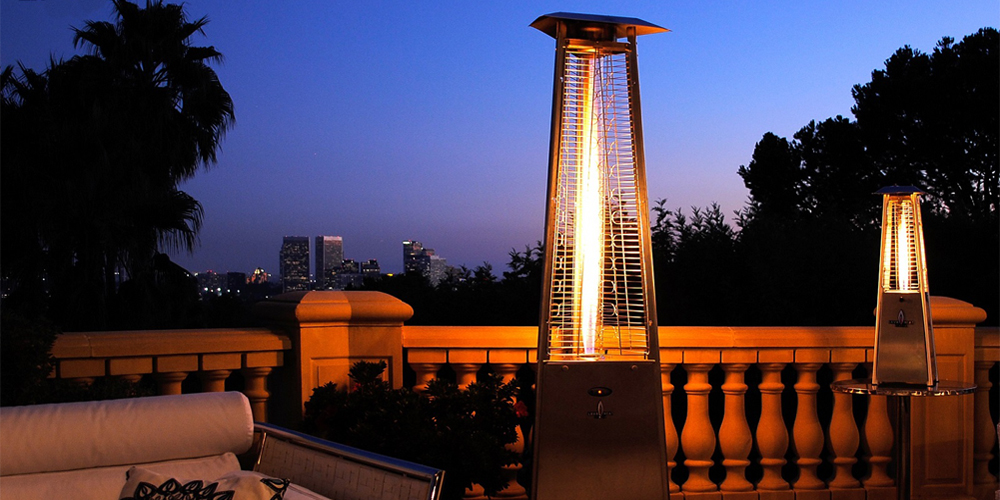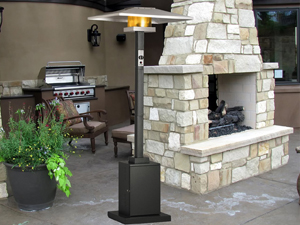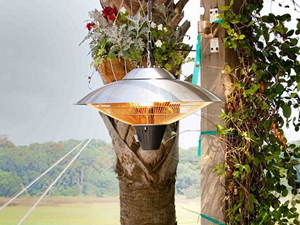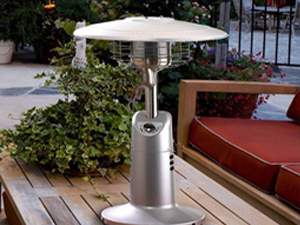



Outdoor heaters add functional and decorative value to your patio, creating a comfortable environment that enables you to enjoy alfresco living longer. Offered in many different styles and types, patio heaters make a great accessory to any patio set. With the diverse selections available, LuxeDecor provides a guide that helps you select the best patio heater to best complement your outdoor setting.

Standing patio heaters come in many different styles and sizes, but are ideal in many outdoor environments for their space-saving upright profiles and sleek silhouettes. Depending on size, standing patio heaters can provide a radius of heat that spans up to 20 feet. Standing heaters are full-sized and often portable, with a compartment for a fuel tank powered by propane gas. On average, standing patio heaters operate at 40,000 BTUs. (BTU stands for British Thermal Unit. One BTU can heat one pound of water by one degree Fahrenheit. To learn more about BTUs, see the Patio Heater Size section).

A mounted patio heater is constructed for permanent use within a designated area of your outdoor space. Generally mounted to a wall, these convenient heaters save space and are ideal on a deck or sunroom. Depending on the size of the unit, mounted patio heaters can range as small as under 10,000 BTUs of heat to more than 30,000 BTUs.

A hanging patio heater can be hung from above any semi-enclosed outdoor space with a ceiling. Ideal for small spaces, a hanging patio heater is an attractive addition to any patio set up, providing discrete heat that doesn’t take up space on walls, floors, or tabletops. Most hanging patio heaters are electric powered and can range in power from under 10,000 BTUs to 30,000 BTUs.

Tabletop heaters are easily portable and transportable, and are especially useful in small, confined spaces such as balconies. These petite sized patio heaters are generally powered by electric or propane gas. Propane gas models will feature a compartment to discretely hold a propane tank, and do not produce more than 30,000 BTUs.
A British Thermal Unit (BTU) is a measure of the heat content in fuels. BTU measures the quantity of heat required to raise the temperature (in Fahrenheit) at the temperature that water displays its maximum density (approximately 39 degrees Fahrenheit). The average standing heater will produce 40,000 BTUs which is enough to heat a large crowd. On average, small tabletop heater models create 12,000 BTUs which is enough to heat a medium sizes group standing close within its proximity. The following outlines the recommended BTUs to heat an area of space:
Area In Sq. Feet
Recommended BTUs
100-150 sq. ft.
5,000
150-250 sq. ft.
6,000
250-300 sq. ft.
7,000
300-350 sq. ft.
8,000
350-400 sq. ft.
9,000
400-450 sq. ft.
10,000
450-550 sq. ft.
12,000
550-700 sq. ft.
14,000
700-1,000 sq. ft.
18,000
1,000-1,200 sq. ft.
21,000
1,200-1,400 sq. ft.
23,000
1,400-1,500 sq. ft.
24,000
1,500-2,000 sq. ft.
30,000
2,000-2,500 sq. ft.
34,000



